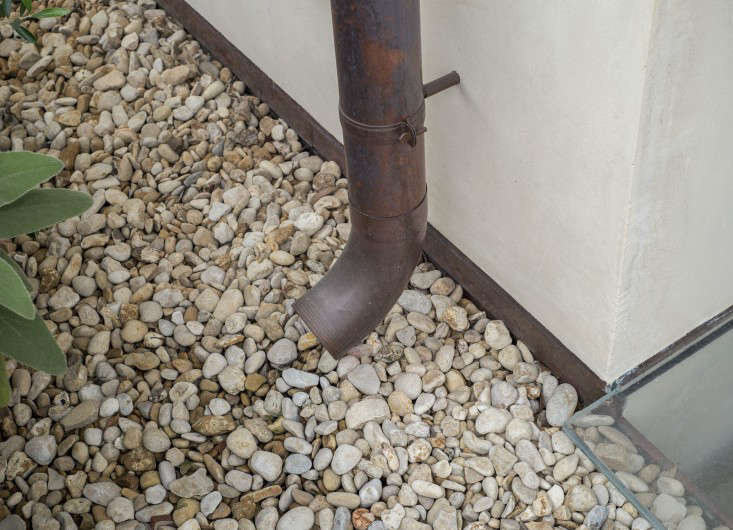Add the word “French” to anything and it sounds elegant. This works even with a boring, vaguely hostile word like “drain,” a feature of your hardscape that you generally don’t want to think about; let’s just hope a drain is doing its job and leave it at that. But a French drain? I want one.
Imagine my consternation upon learning that the French drain is not from France at all but was actually created by an American named Henry French. In the mid-1800s, French came up with the idea of leaving a gap between roof tiles to allow water to drain efficiently. Thus was born the French drain. You can read more about it in French’s seminal 1859 book, Farm Drainage (does this make him a French author?), in which he discusses at length his ideas for draining land “with stones, wood, plows, and open ditches, and especially with tiles.” Or we can move on.
Despite its prosaic American past, the French drain is quite a useful method of diverting water and preventing floods or runoff. A French drain can be installed on a roof, around the foundation of a house, at the base of a retaining wall, around the perimeter of a cellar, or on any slope. The simple idea behind a French drain is this: Dig a trench to channel water downhill and fill the trench with gravel so the water can filter down to the bottom of the trench. At the bottom install a pipe to capture water and encourage it to flow in a direction away from a house.
Read on to find out if a French drain should be part of your hardscape design.
Photography by Matthew Williams for Gardenista.
Do I need a French drain?

If your basement floods after a rain or your lawn feels squishy and wet underfoot, you need better drainage. Consult a professional: A civil engineer can determine whether the problem is surface runoff or underground water and devise a solution.
Some people may feel hiring an engineer is overkill. But as someone who has installed three French drain systems in three different houses, I can attest to the fact that improper installation renders the whole system worthless. You do not want to pay a handyman or gardener to install a French drain only to learn the next time it rains that you still have a flooding problem because … well, maybe the trench wasn’t deep enough. Or the drain’s location was wrong. Or the pipe is getting clogged by roots. Or the pipe is overflowing because it’s not big enough to handle the water flow. I could go on and on, but frankly, I have spent too many years trying to repress these memories to unleash them now. Please. Consult a professional.
What are alternatives to a French drain?

Sometimes a sump pump is needed, particularly if water is seeping into a space below grade (such as a basement or crawl space). If you install a sump pump in a specially constructed pit, it can capture water and direct it outdoors to prevent dampness and flooding elsewhere in a basement. Consult a drainage specialist for advice.
Gutters and downspouts can direct water away from a house, as well. For more information, see Hardscaping 101: Rain Gutters.
What are the components of a French drain system?

Basically, you need to dig a trench on an angle to ensure that water will run downhill. Then lay a length of perforated pipe at the bottom, and fill the trench with gravel. This is your French drain system. You can leave it exposed, or you can cover it with a grille or other decorative element if you prefer.
Can I install my own French drain?

If you like to dig endless backbreaking trenches, then yes, you can install your own French drain. But generally speaking, you are better off consulting a specialist who will know—based on your particular water situation—how deep to dig, how sharply to angle the trench, and where to direct the runoff.
Generally, French drains direct water to the street, a drainage ditch, or a dry well. If you have a low-lying pond on your property, this also could be a destination.
How much does a French drain cost?

Hiring someone to install an outdoor French drain costs on average $25 per linear foot in a trench that is one to two feet deep and from six to 18 inches wide, according to Costhelper.
If you install your own outdoor French drain (which as you already know I do not recommend), the labor is free and the cost of construction materials will include crushed rock for about $2 per square foot; PVC pipe and fittings, and rental fees for equipment: a compactor rents for $65 to $85 per day. A trencher costs $50 to $80 to rent for half a day, and a small backhoe costs $150 to $200 a day to rent, according to Doityourself.
If installing a French drain indoors in a basement, prices will vary widely depending on the size of the basement; expect to pay $2,000 to $6,000 to cut a channel around the perimeter and fill it with gravel, says Costhelper. (Adding a sump pump and basin will set you back another $10,000 to $15,000.)
N.B.: This post is an update; it was first published September 2018.
Feeling drained? Or are you inspired to tackle more projects? See our curated design guides to Hardscape 101, including Decks & Patios and Fences & Gates. Read more:
- Hardscaping 101: Sump Pumps
- Garden Envy: 10 Dramatic Drainage Ideas to Steal
- Hardscaping 101: Rain Gutters












Have a Question or Comment About This Post?
Join the conversation (3)